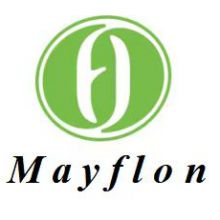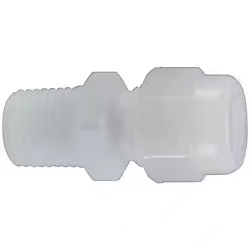-
 joyna
Hi there! Welcome to my shop. Let me know if you have any questions.
joyna
Hi there! Welcome to my shop. Let me know if you have any questions.
Your message has exceeded the limit.

Let me show you a brief history of the development of fluorine resin!
2023-09-06 18:03:39
Polyvinyl chloride (PCTFE) is the earliest fluoropolymer developed and commercialized.
In 1934, F. Schloffer and O.Scherer of the German company I.G. Farbenindustrie invented polyvinyl chloride (PCTFE) and applied for the first fluoropolymer patent, which was authorized in 1937. In 1937, the German company I.G. Farbenindustrie published its first preparation report.
In 1938, when Dr. Plunkett of Du Pont in the United States studied fluorinated refrigerants, he hoped to synthesize a safe and effective refrigerant through tetrafluoroethylene (TFE). One day, when he checked the cylinder filled with TFE gas, he found nothing, and the weight of the cylinder had not changed. When the valve was removed to shake the cylinder, he saw that a few grams of wax-like white powder was generated on the wall of the bottle. After analysis, it was determined that the white powder was PTFE. After testing, he found that PTFE was insoluble in any acid, alkali and organic solvents until it melted, it only formed a tough transparent colloid without flowing. Later, it was found that it could only be molded by powder metallurgy.
At that time, the United States was looking for a novel corrosion-resistant material to realize the Manhattan project as the lining and sealing material of equipment in the process of uranium hexafluoride treatment. The discovery of PTFE just met the requirements. Until the end of World War II, the U.S. government kept the secret to the outside world. Du Pont named PTFE as Teflon in 1944, small batch production after solving monomer synthesis and polymerization technology in 1947, and built a factory to expand production in 1950. The Manhattan Project also produces a variety of other fluorine products, including PVDF, which is mainly used for valves, corrosion-resistant pipes and lubricants, from which the fluoropolymer industry began.
In 1953, Kellog Co. The company began to sell polychlorotrifluoroethylene (PCTFE) under the trade name Kel-F81. PCTFE is a homogeneous polymer of trifluoroethylene chloride (CTFE). The fluoropolymer skeleton contains chlorine, which improves processing performance and replaces PTFE in some applications. PCTFE has greater hardness and lower permeability than PTFE. It has excellent moisture resistance and can be polymerized in solution and suspension.
In 1960, researchers synthesized the first copolymer of TFE, FEP (polyperfluoroethylene) for the first time, using the copolymerization of tetrafluoroethylene (TFE) and hexafluoropropylene (HFP). FEP has relatively good processing performance and can be processed with traditional technologies, such as molding and casting. It is often used in the production of refractory wires and insulated cables.
In 1961, DuPont in the United States developed PVF. Compared with other fluorinated polymers, the fluorine content of PVF and PVDF is low, which not only maintains the chemical resistance and heat resistance of PTFE, but also has excellent mechanical strength similar to that of hydrocarbon-based polymers. PVF is especially suitable for the layering process. The processed film is very tough, waterproof and sunproof, and has gradually become an excellent material for spraying coatings.
In 1965, Pennsalt launched the first commercial-grade PVDF, with the product name Kynar500. DuPont discovered perfluorosulfonic acid (Nafion) in the late 1960s, a TFE copolymer containing a sulfonic acid group. Nafion is the first synthetic ionic polymer (ion crosslinked polymer), which has high electrical conductivity to cations and is used in membrane materials, industrial electrolysis and fuel cells.
Later, modified fluoroion polymers, such as Fremion and Aquivion, were developed. In the 1970s, a perfluoroalkoxy (PFA) copolymer, a mixture of TFE and perfluoronpropyl vinyl ether (PPVE), was introduced. With the performance of FEP and PTFE, it was quickly applied in the chemical and semiconductor industries, such as pipes, accessories, linings and special films.
During the same period, DuPont also launched ethylene copolymers of CTFE and TFE, namely ECTFE and ETFE. These polymers are the first fluoropolymers to contain non-fluoro groups. The production cost is low. At the same time, they have the properties of hydrocarbons and fluorocarbon polymers. In addition to improved mechanical properties, ETF E and ETFE have excellent elastic properties and are commonly used as high-strength pipes, films and refractory cable insulation materials.
In 1976, Robert Gore thermally stretched polytetrafluoroethylene (PTFE) to 800% to form a microporous structure, of which 70% was air, resulting in expanded polytetrafluoroethylene (ePTFE). By controlling the size of micropores, ePTFE can be designed as a breathable and impermeable material. The product of this new material is called Gore-Tex, which has had a positive impact on the development of outdoor clothing, medical and music industries.
In the early 1980s, Japan's Asahi Nitium Corporation (now AGC, later the same) developed a fluoroethylene ether (FEVE) resin, which is a mixture of fluorinated ethylene (TFE or CTFE) and ethylene ether. It is soluble in organic solvents and can be cured at room temperature. It is marked as Lumiflon and is used in plastic paint, construction and other materials. The fluoropolymers in this period are semi-crystalline materials with poor solubility, optical properties and transparency.
In the mid-1980s, DuPont developed a fluorinated polymer, Teflon-AF, a homogene of TFE and perfluoroalkoxy-2,2-dimethyl-1,3-dioxycyclopentene (PDD). Xu Nitoxide's subsidiary developed a perfluorocyclic polymer - Cytop. This is a homogeneous polymer of trifluoromethyltrifluorovinyl ether. Both polymers are amorphous high molecular weight perfluorinated polymers. In addition to their excellent thermal, chemical and electrical properties, they also have the lowest refractive index among all known organic materials, making them an ideal choice for optical lenses, optical fiber applications and high-quality transparent coatings. Later, Solvay launched Hyflon AD as a replacement for Teflon-AF. At present, the consumption of amorphous fluoropolymers is still very small.
In 1993, Hoechst (Herst) cooperated with 3M to launch THV, a semi-crystalline three-composed ternary copolymer composed of TFE, HFP and VDF. It is highly flexible, soluble in polar organic solvents, and has excellent adhesive properties, which is very suitable for Thin film coating and multi-layer structure.

